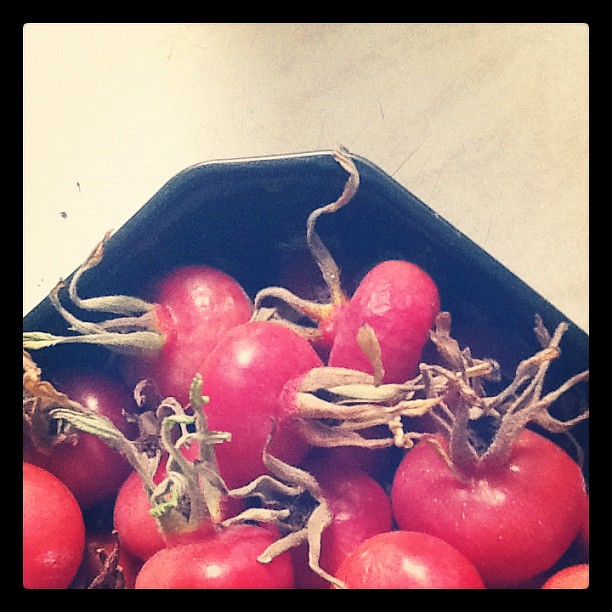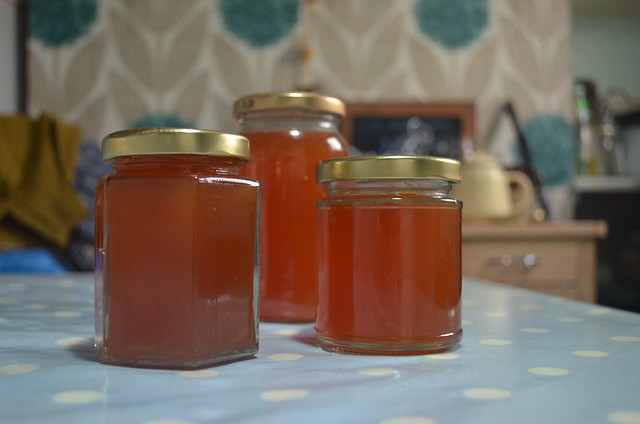

If any of you follow me on instagram (or twitter and flickr come to think of it) you will have noticed these images pop up last week as I pootled in the kitchen making rose hip syrup.
These rose hips were a free treat from the local farm and I may even gather some more before the season ends, because as we all know rose hips are an amazing source of vitamin C (and A,D, and E with a copious amount of antioxidants) with having twenty times more vitamin C than oranges and one of the highest vitamin C content in the whole plant kingdom.
Rosehip syrup has always been known here since WWII when British commercial ships were being torpedoed by enemy submarines meaning a range of fruit were almost impossible to import. Being a nation familiar with scurvy (not for no reason are we called Limeys) the Ministry of Food sought to improve the life of Britons by encouraging the use of anything to hand to keep us well. The resurgence of growing one's own food (digging for victory) and making do and mending were a way of life for generations of Britons in the War and post-War ration period. My mother remembers schools encouraging children to pick hips to donate to the cause so syrup could be made (1 penny a pound of good hips).
The syrup itself was seen as a medicine, to help fight colds and flu (it is also an anti-inflammatory for all kinds of arthritis), and in the winter months when fruit is scarce it is a great source of essential vitamins. Even I remember having to drink the sickly sweet drink to stave off colds.
So, in the tradition of making do and mending, and growing our own, and digging for victory and all that jazz I decided I could no longer let this abundance of goodness go to waste. And in the spirit of sharing and caring here is the recipe I used for your own use too::
Rosehip Syrup Recipe ::
Ingredients
1kg rosehips
1kg caster sugar
2L water
To Make
1. Put two litres of water in a large pan and bring to the boil.
2. chop the rosehips, and place in the boiling water
3. bring back to the boil, then remove from the heat, cover and leave to infuse for half an hour, stirring from time to time.
4. Strain the mixture through a jelly bag. (Alternatively, line a colander with a couple of layers of muslin and place over a large bowl.)
5. Set the strained juice aside and transfer the rosehip pulp back to the saucepan, along with another litre of boiling water. Bring to the boil, remove from the heat, infuse for another half an hour and strain as before.
6. Discard the pulp and combine the two lots of strained juice in a clean pan. Bring to the boil, and boil until the volume has decreased by half.
7. Remove from the heat.
8. Add the sugar and stir until dissolved.
9. Return to the stove, bring to the boil and boil hard for five minutes. Pour into warmed, sterilised jars or bottles and seal.
Label your jars and store in a dark cupboard. Once opened keep in the fridge and use within one week.
You can use this as a drink (dilute as you would any cordial), or replace as a syrup over pancakes, waffles or icecream!
Any rose hip is edible, although you might find commercial varieties of rose unpalatable. Picking wild rose (dog rose) ensures a good taste.

Enjoy!


I love rosehip syrup on porridge- I pop a stick of cinnamon in with the fruit for a change sometimes... lovely blog by the way (through Soulemama!)
ReplyDeleteI think I'm a bit allergic to cinnamon actually, but yes, definitely on porridge too! Thankyou for blog love....
ReplyDeleteAaa ah. I have a garden full of rose hips, and now I know what to do with them. Thank you
ReplyDeleteYou are very welcome! :)
ReplyDeletethank you for the recipe! When you say seal the jars, do you mean process them like you would when canning (hot water bath)?
ReplyDeleteThe way we do it here is different to the USA. I've never canned using a hot water bath, so long as everything is sterile before you start you can just seal with a wax disk or mason lid and add the seal and it should be fine. If you want to then use a hot water bath you could try that too. No harm no foul!
ReplyDeleteIf this is rich in Vitamin C, it must be a good ingredient to put in cough syrup, or any kind of mucolytic medicine. And I find yours very organic and free from any chemicals. You should also be aware of proper storage so that you can use it for longer period.
ReplyDeleteOra @DABrico.com
Yep we use sterilised jars and add a wax circle to the top before lidding it.
ReplyDelete